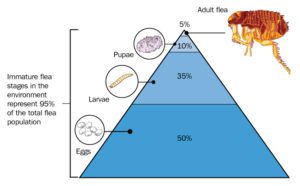HOW TO CHECK YOUR HOME (NOT YOUR PET) FOR FLEAS
By Chris Williams on June 28, 2019.
You’ve just discovered that your dog has fleas. The veterinarian has treated the dog, a very important first step, but is that all you need to do?
Actually, there’s more. If you don’t also have your home inspected and treated by a pest management professional, fleas are likely to show up again, perhaps biting people in your home instead. The reason is that immature fleas are likely developing right now in hidden areas in your house. Killing the adult fleas on your dog will have no effect on this next generation. If you learn a little bit about flea biology and lifecycle, you will understand why.
DEVELOPING FLEAS ARE NEVER FOUND ON YOUR PET!

Flea life stages. Shutterstock.
Immature fleas do not look or act like the dark, jumping, blood-feeding adult fleas. They are whitish, worm-like larvae that have no contact with your dog and do not suck blood (see What Do Baby Fleas Look Like?) You never see flea larvae on your dog and you hardly ever see adult fleas off of your dog. An adult female flea spends all of her time burrowed into your pet’s hairs, occasionally sucking its blood, and laying about 20 eggs a day in her spare time.
The dry eggs fall off of your pet and end up most often in your pet’s bedding or wherever it spends most of its time. When the eggs hatch in a few days, the tiny, legless larvae stay pretty much where they are. They feed mostly on dried blood that they get from feces that has dropped from adult fleas, also in the areas where your pet rests. After a couple of weeks of feeding, the larvae pupate inside a cocoon. Adult fleas emerge from the cocoon days, or even months later, depending on the availability of a blood food source.
CHECK YOUR PET’S BEDDING AREA FIRST

Pets in their bedding. Shutterstock.
Your pet’s bed, or the blanket he sleeps on, or the area where he spends the night is generally the best place to find evidence of flea eggs, larvae, pupal cocoons, and specks of adult flea feces. When you first see them all together, it might look like someone sprinkled “salt” (white eggs, larvae, pupae) and “pepper” (black feces from adult fleas) into the pet’s bed. Whether you find fleas in the bedding or not, since you’ve had a flea problem, you need to regularly check and wash the bedding (see How to Get Rid of Fleas in Your Pet’s Bedding). If you don’t know what flea larvae look like, checking pet bedding first should give you an idea. (Hint: They’re much smaller and skinnier than you think.)
OTHER PLACES TO LOOK FOR EVIDENCE OF FLEAS
Other secondary places to check are along your pet’s travel routes in the house. Larvae hide in crevices or in carpeting whenever possible. Check along the less disturbed edges of hallways, along baseboards, under carpet tack strips, etc. For hard surface floors, check gaps between boards, missing caulking, cracks, and seams. In carpeting, all stages end up at the base of the carpet pile and are very difficult to see and vacuum. If the pet sleeps on the sofa or a stuffed chair, look under the cushions and under the furniture. Also check the places where your pet lands when it jumps down from the bed or sofa. Research has shown that these “landing spots” have high numbers of flea eggs and feces that are dislodged from the pet when he hits the floor.
TREATMENT OF YOUR HOME IS AN IMPORTANT STEP
Remember, your pet is now protected from biting fleas, but you are not. You can continue looking for developing fleas or you can call Colonial Pest. Even if you don’t see evidence of developing fleas, don’t skip this important final step in a total flea control program. If we eliminate any fleas that might be developing now in your home and you make sure that your pet is always protected from biting fleas, neither you nor your pet should have to worry about fleas again!